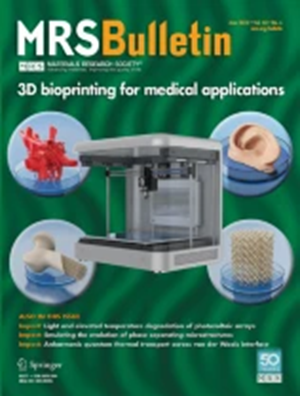氢在能源和信息科学中的应用
IF 4.1
3区 材料科学
Q2 MATERIALS SCIENCE, MULTIDISCIPLINARY
引用次数: 0
摘要
作为元素周期表中的第一元素,氢除了具有迷人的化学性质外,它在能源技术方面也具有高度的社会重要性,在节能计算方面的重要性也与日俱增。在能源领域,氢已重新成为长期能源储存的潜在解决方案和材料制造的无碳输入。氢的利用和生产有赖于燃料电池和电解槽组件中质子传导电解质和混合质子电子导体的可用性。在计算领域,质子对电子特性的调节已引起人们对电化学控制的高能效神经形态计算的关注。在氧化物中掺入取代离子和间隙氢化物离子虽然只是最近才确立的,但却能调整电子和磁性能,从而带来一系列可能的奇特应用。本文探讨了氢在氧化物中掺入和传输的基础科学中与迫切技术需求相关的共同主题。内容包括:(1) 氢的晶格(或块体)传输机制,主要涉及质子传输,但也涉及氢化物离子传输;(2) 界面传输;(3) 利用极端外部驱动因素实现非同寻常的响应;以及 (4) 氢环境和传输途径探测方法的进展。这里描述的含氢材料领域的研究活动快照强调了令人兴奋的最新突破、尚待解决的问题以及目前可用来揭示固态物质中氢的性质的令人惊叹的实验工具。图表摘要本文章由计算机程序翻译,如有差异,请以英文原文为准。

Hydrogen in energy and information sciences
Beyond its fascinating chemistry as the first element in the Periodic Table, hydrogen is of high societal importance in energy technologies and of growing importance in energy-efficient computing. In energy, hydrogen has reemerged as a potential solution to long-term energy storage and as a carbon-free input for materials manufacturing. Its utilization and production rely on the availability of proton-conducting electrolytes and mixed proton–electron conductors for the components in fuel cells and electrolyzers. In computing, proton mediation of electronic properties has garnered attention for electrochemically controlled energy-efficient neuromorphic computing. Incorporation of substitutional and interstitial hydride ions in oxides, though only recently established, enables tuning of electronic and magnetic properties, inviting a range of possible exotic applications. This article addresses common themes in the fundamental science of hydrogen incorporation and transport in oxides as relevant to pressing technological needs. The content covers (1) lattice (or bulk) mechanisms of hydrogen transport, primarily addressing proton transport, but also touching on hydride ion transport; (2) interfacial transport; (3) exploitation of extreme external drivers to achieve unusual response; and (4) advances in methods to probe the hydrogen environment and transport pathway. The snapshot of research activities in the field of hydrogen-laden materials described here underscores exciting recent breakthroughs, remaining open questions, and breathtaking experimental tools now available for unveiling the nature of hydrogen in solid-state matter.
Graphical abstract
求助全文
通过发布文献求助,成功后即可免费获取论文全文。
去求助
来源期刊

Mrs Bulletin
工程技术-材料科学:综合
CiteScore
7.40
自引率
2.00%
发文量
193
审稿时长
4-8 weeks
期刊介绍:
MRS Bulletin is one of the most widely recognized and highly respected publications in advanced materials research. Each month, the Bulletin provides a comprehensive overview of a specific materials theme, along with industry and policy developments, and MRS and materials-community news and events. Written by leading experts, the overview articles are useful references for specialists, but are also presented at a level understandable to a broad scientific audience.
 求助内容:
求助内容: 应助结果提醒方式:
应助结果提醒方式:


